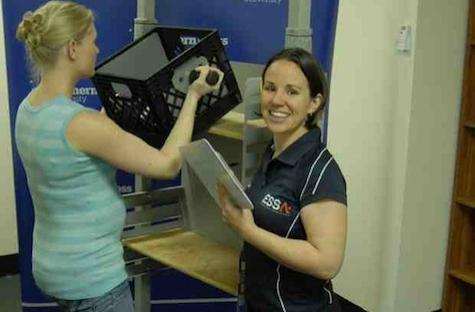Pregnant women are quite capable of lifting heavy objects safely, according to research from Southern Cross University.
PhD candidate Nellie Buckley, from the School of Health and Human Sciences, will present initial findings from her research into lifting and pregnancy in the final of the Trans-Tasman Three Minute Thesis Competition at the University of Western Sydney on October 18.
"Lifting forms the basis of many physical activities and is part of daily life especially for mothers," Mrs Buckley said.
"Physical activity guidelines encourage women who become pregnant to maintain their physical activities, despite this healthcare providers often advise pregnant women not to lift heavy objects.
"Pregnancy is a time in a woman's life where she can easily increase her fat stores and therefore readily gain weight. So you might see a situation where a woman becomes inactive during pregnancy as a result of misinformation, doesn't gain the benefits of physical activity in her pregnancy and then gains more than a healthy amount of weight and this may not be good for her or the baby in the long term.
"The lifting capacity for pregnant women is unknown as are the effects of pregnancy on lifting capacity so I utilised a functional assessment to determine lifting capacity based on physiological, biomechanical and psychological measures."
Using this assessment, Mrs Buckley tested 67 pregnant women during various stages of pregnancy who lifted a milk crate containing a quantity of weight. This involved the participant, who did not know how much she was lifting, repeatedly lifting the crate as more weight was added until she reached her maximum acceptable lifting weight.
"I assessed each woman's lifting capacity using an incremental, standardised assessment with an emphasis on safety, investigating three common ranges of motion - lifting from waist to shoulder, floor to waist and floor to shoulder," Mrs Buckley said.
"Each participant's heart rate was monitored and she was assessed for signs of overexertion or unsafe lifting technique. Her perceptions of the task were recorded; she was asked to rate the load, she was asked if she could lift it safely 8-12 times and if she could lift more.
"I combined these aspects to determine her maximum lifting capacity. The least amount lifted was 4.5 kilograms and the most lifted was 40 kilograms, which is quite substantial. The average for each lift was 15.95 kilograms.
"These findings could help inform healthcare providers of the individual factors to consider in the advice they give to pregnant women in regards to lifting during their pregnancy.
"It is important that pregnant women are being given reliable information about what is, and what is not, safe. They should be encouraged to lift to their capacity."
Mrs Buckley stressed that pregnant women should seek individual advice from health care professionals in regards to exercise.
The Three Minute Thesis Competition is a research communication competition in which higher degree research students present their work in three minutes. It helps students develop their communication skills and promotes informing the general public about current research. The competition encourages presenters to present research in a manner that is easily understood.
This competition was developed in 2008 at the University of Queensland and has now become a national Australia and New Zealand competition and has also spread across the world. Southern Cross University has previously competed in 2011 and 2012.
Photo: Nellie Buckley.








 Agree (0)
Agree (0) Disagree (
Disagree (











__small.png)










